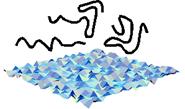Current & Past Research
Molecular Design of Chemically Selective Surfaces
 Interfacial interactions are critical in areas that are of wide relevance to everyday life. Examples include adhesion, bio-compatibility, wetting, chemical sensing, and surface adsorption.
Interfacial interactions are critical in areas that are of wide relevance to everyday life. Examples include adhesion, bio-compatibility, wetting, chemical sensing, and surface adsorption.
Our research group builds on our expertise in the molecular design of surfaces to create smart surfaces. One focus of our research is surfaces that exhibit chemical selectivity and recognize chemical species by virtue of their shape and molecular size.
Engineering Stimuli-Sensitive Polymeric Materials
 One focus of our research is on engineering stimuli-sensitive polymeric materials.
One focus of our research is on engineering stimuli-sensitive polymeric materials.
These materials respond to external fields such as pH, temperature, and light, and are of great interest for active control of properties of surfaces and bulk solutions.
Our research group is working with polymers that are thermally responsive.
Controlling Assembly of Nanoscale Materials
 The increasing ability to prepare nanomaterials of various sizes, shapes, and materials has spurred the need for strategies to assemble these nanomaterials into constructs for functional devices such as sensors, photonic materials, and biomolecular electronics. In this context, our group has focused on directed self-assembly of various nanomaterials.
The increasing ability to prepare nanomaterials of various sizes, shapes, and materials has spurred the need for strategies to assemble these nanomaterials into constructs for functional devices such as sensors, photonic materials, and biomolecular electronics. In this context, our group has focused on directed self-assembly of various nanomaterials.
Nano-heterogeneous Surfaces and Adsorption of Flexible or Globular Polymers
 Polymer adsorption on surfaces is one area of research that blends our interests in surface science and polymer materials. The research is motivated by the common occurrence of heterogeneity on real surfaces and the widespread applicability of polymer adsorption in adhesion, lubrication, control of cell adhesion to surfaces, and biocompatibility of surfaces.
Polymer adsorption on surfaces is one area of research that blends our interests in surface science and polymer materials. The research is motivated by the common occurrence of heterogeneity on real surfaces and the widespread applicability of polymer adsorption in adhesion, lubrication, control of cell adhesion to surfaces, and biocompatibility of surfaces.
